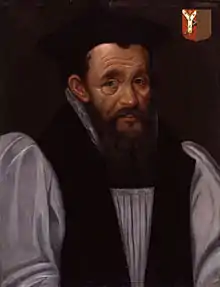The Right Reverend Hugh Curwen | |
|---|---|
| Bishop of Oxford | |
| Church | Church of England |
| Diocese | Oxford |
| In office | 1567–1568 |
| Predecessor | Thomas Goldwell |
| Successor | John Underhill |
| Orders | |
| Consecration | 8 September 1555 by Edmund Bonner |
| Personal details | |
| Born | c. 1500 |
| Died | 1 November 1568 Swinbrook |
| Buried | St John the Baptist, Burford |
| Nationality | English |
| Denomination | Catholic 1528-1534; 1555-1558 Anglican 1534-1555; 1558-1567 |
| Previous post(s) | Archbishop of Dublin (1555–1567) |
| Alma mater | Brasenose College, Oxford |
Ordination history of Hugh Curwen | |||||||||||||
|---|---|---|---|---|---|---|---|---|---|---|---|---|---|
| |||||||||||||
| Source(s):[1] | |||||||||||||
Hugh Curwen (c. 1500 - 1 November 1568) was an English ecclesiastic and statesman, who served as Archbishop of Dublin and Lord Chancellor of Ireland from 1555 to 1567, then as Bishop of Oxford until his death in November 1568.
Previous entries, including the 1911 Oxford Dictionary of National Biography, confused him with Richard Curwen, almoner to Henry VIII.[2]
Life
Born in Bampton, Cumbria, he is thought to have been educated at Brasenose College, Oxford. He had at least two brothers, Christopher and James, who was the grandfather of Richard Bancroft, Archbishop of Canterbury and 'overseer' of the King James Bible.[3]
Career

In February 1528, Curwen gained a degree in Canon law, followed by a Master of Arts in 1532. In 1533, he was appointed Rector in the village of Ferriby, Lincolnshire. The following year, England broke with the Catholic Church and formed the Church of England, led by Henry VIII, rather than the Pope.[2]
In 1541, he became dean of Hereford, followed by a series of administrative posts; when Mary became queen in 1555, he conformed with the restoration of Catholicism. Nominated Roman Catholic Archbishopric of Dublin, he was consecrated on 8 September 1555 by Edmund Bonner. He was also appointed Lord Chancellor of Ireland, and in 1557 served as Lord Justice of Ireland during the absence of the Lord Deputy of Ireland, the Earl of Sussex.
When Elizabeth succeeded in 1558, only five Irish bishops accepted the Religious Settlement, Curwen being one of them. He remained Archbishop and Lord Chancellor until 1567, but was accused of 'moral delinquency' by Hugh Brady and Adam Loftus, apparently for his reluctance to implement key religious reforms.[4]
Curwen suffered from palsy and poor health made it increasingly difficult to continue his duties; in 1564, he obtained a sinecure position for his nephew Richard Bancroft at St Patrick's, Dublin.[3] Apparently 'speechless and senseless', he was finally allowed to resign in June 1567, when he became Bishop of Oxford. He died at his home in Swinbrook in October 1568, and was buried at St John the Baptist, Burford. The diocese of Oxford remained vacant until 1589, when John Underhill became bishop.[5]
References
- ↑ Archbishop Hugh Curwen
- 1 2 Walshe 2008, pp. Online.
- 1 2 Cranfield 2008, pp. Online.
- ↑ Murray 2009, pp. 242–245.
- ↑ "List of Bishops of Oxford from 1542 to the present". Oxford History. Retrieved 30 November 2019.
Sources
- Cranfield, Nicolas S (2008). Bancroft, Richard (Online ed.). Oxford DNB. doi:10.1093/ref:odnb/1272.
- Walshe, Helen Coburn (2008). Curwen [Coren], Hugh. Oxford DNB. doi:10.1093/ref:odnb/6966.
- Murray, James (2009). Enforcing the English Reformation in Ireland: Clerical Resistance and Political Conflict in the Diocese of Dublin, 1534 - 1590. Cambridge University Press. ISBN 978-0521770385.
- John D'Alton, Memoirs of the Archbishops of Dublin (Dublin, 1838).
External links
- "List of Bishops of Oxford from 1542 to the present". Oxford History. Retrieved 30 November 2019.
- Chisholm, Hugh, ed. (1911). . Encyclopædia Britannica. Vol. 7 (11th ed.). Cambridge University Press. p. 664.